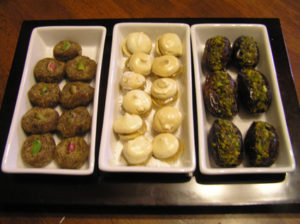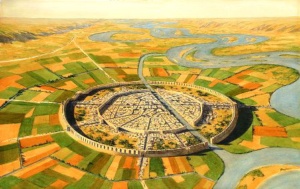The fourth entry in the Mesopotamian Cookoff comes to us all the way from Australia. Catherine McLean has pulled out the stops and created three new different dishes based on the Mersu recipe from Mari. The first is a stuffed dates dish, the second is a Date and Pistachio “Sweetmeat” and the third is a Pistachio, Honey and Date Macaron – and they all look absolutely delicious!

Catherine writes, “I got as far as the first recipe, Mersu (ingredients: dates and pistachios), and pretty much stopped there. I mean, I live just about at the hub of Middle Eastern food stores in Melbourne, so getting really good quality pistachios and dates (not to mention many, many other ancient Near-Eastern ingredients) is easy. For another thing, it’s dessert! And for a third thing, I had about five recipes in my head before I even finished reading the sentence.
The sum of the Mersu recipe was “Ingredients: dates and pistachios”. The rule is that one couldn’t go too far beyond the ingredients listed, and should stick to ingredients found in the Near East in ancient times. My personal rule was that the first two recipes I thought of were too easy and so I had to make something really insane for the third one. Hence, we have dates stuffed with saffron and honey pistachios, date sweetmeats with pistachio and coriander seed, and something I’m going to call a pistachio and honey macaron with date curd. But I’m lying a bit about the macaron part, because I’m pretty sure you can’t make a proper macaron without using sugar (not commonly available in ancient times), so the biscuit part has a texture and flavour somewhere between meringue and nougat. Nothing to dislike there. Though if I weren’t doing a Mersu challenge, I would probably have made a dried cherry filling rather than a date one.
I couldn’t resist making a platter of three possible Mersus -one which might well have been made in ancient times, one which might be made in the Middle East today, and one which nobody in their right mind would make in any time – a sort of pistachio and honey macaron with date curd.”
_____________
Three Mersu Recipes by Catherine McLean
Stuffed Dates (inspired by modern Middle-Eastern cuisine)
Ingredients
18 large dates, preferably mejdool (about 500 g)
150 g pistachios
60 g honey
60 g water
a few strands of saffron
1/2 tsp orange flower water or rosewater (optional)
Directions
Carefully slit the dates and remove the stones. Put pistachios, honey, water and saffron in a saucepan and cook briefly, until the pistachios have absorbed most of the moisture. Pound or blend them to a coarse paste with the orange flower or rose water. For a smoother paste, add a little more water or a little more honey.
Stuff the dates with the pistachio paste, and serve.
_____________
Date and Pistachio Sweetmeats (inspired by ancient Roman cookery and in particular the wonderful cookbook by Mark Grant)
Ingredients
200g dates, preferably mejdool (about 8 large dates)
1-2 tbsp ground coriander seed
about 12 pistachios
Directions
Remove the stones from the dates, and pulverise in a food processor (or mortar and pestle, if you are completely loony) until they form a sticky purée. This is much more of a pain than you might think. With wet hands, collect the purée into a ball and roll into a cylinder using clingwrap.
Sprinkle ground coriander onto a plate. Slice the date purée into about 12 thick ‘coins’ about the size of a fat 10 cent piece (they will squish when you slice them, but you can use wet hands to re-shape them). Coat the discs with the coriander, then toss from hand to hand so that the thinnest possible dusting of coriander remains on the sweetmeat. Press a pistachio into the centre of each coin, and serve.
__________
Pistachio, Honey and Date Macarons (inspired by my own fevered imagination)
Ingredients
1 egg yolk + 2 egg whites
40 g + 150 g honey
1/2 cup milk
1/4 cup dates, finely chopped (about 3 large dates)
1/4 tsp cinnamon, optional
10 g flour
25 g pistachios
Directions
To make the filling, heat the milk with the dates and cinnamon, if using, slowly until almost boiling. Beat the yolk, 40g honey and flour together until smooth, then pour the milk into the yolk mix, whisking madly as you do. A Mesopotamian cook would not use the microwave to make this curd, but I draw the line at a bain marie over an open fire. Set the microwave to 50% and cook for about 3 minutes, whisking every 30 seconds or so, until very thick. Let cool in the fridge.
For the meringue Pour boiling water over the pistachios and leave for five minutes, then drain the pistachios and slide them out of their skin. Grind the pistachios coarsely.
Beat the egg whites until foamy, add 150 g of honey, and continue beating until peaks form and are stiff enough that when you lift the beaters they remain peaky. Fold in the pistachios and pipe little 20 cent piece-sized meringues onto baking paper on a baking sheet. Bake at 120°C for an hour, or until they are a little beige. They will be strangely rubbery and sticky on top when you take them out, but will crisp up as they cool (which they do very fast), and have a texture like nougat. They will also start melting after a couple of hours, and become nougat-flavoured marshmallows by the next day, so make them at the last possible minute before you plan to serve them.
Assemble the macarons by putting about 1/4 teaspoon of filling onto the base of one meringue and topping with another. Frankly, I gave up on authenticity at this point, and put them on a bed of powdered sugar to counteract the stickiness.
Makes more than you can eat before they start melting.
________________
The city that the mersu “recipe” comes from is the ancient Syrian city of Mari that was discovered in the early 1930s when Bedouin tribesmen dug into a mound to construct a grave for a fallen tribesman and found a finely worked, headless statue. Archaeologists descended upon the site and recovered more than 20,000 cuneiform tablets written in Akkadian that covered laws, administrative process and many other topics of everyday life in ancient Syria. The recipe most often discussed by Bottero is from around 1800 – 1750 BCE.

There is evidence that the recipe is far older than the one recovered from Mari, however. Tablets from Nippur dated more than 1000 years earlier discuss the construction of “ninda-i-de-a” for a religious ritual, which some scholars equate with mersu. The ingredients for the older mersu are both sweet and savory and are discussed at the end of the post on the first mersu dish cooked by Sasha Martin. Whatever mersu was to the ancient Mesopotamians, the possibilities are not limited to a cake as envisioned by Bottero or a bread as envisioned Sigrist. Stay tuned for more Mesopotamian dishes in the weeks to come. (Words by Catherine McLean and Laura Kelley; Recipes and Food photos by Catherine McLean; Illustration of Mari by Balage Balogh from Wikimedia.)
